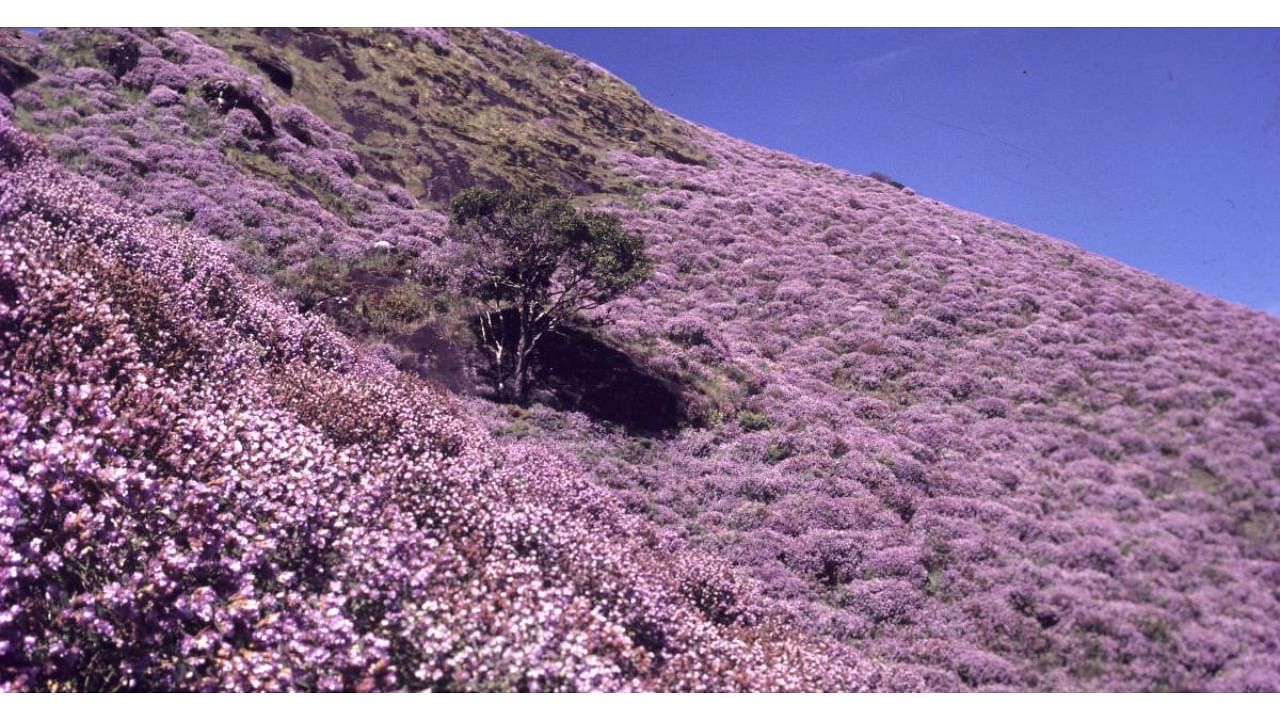
The public imagination may be stoked by scenes of Neelakurinji blossoms across entire hillscapes in the southern Ghats of Kerala and Tamil Nadu once every 12 years. But Karnataka too has blooms that, for the most part, are going unnoticed.
Even as attention is riveted on the flowering of the most famous of the Neelakurinji species, the Strobilanthes Kunthiana, in Idukki and Shalom Kunnu, in Karnataka Strobilanthes Sessilis var. Sessiloides bloomed in Kodagu in August this year. Now, additional blooms are starting in Chikkamagaluru, an event that has nevertheless heralded little fanfare.
Ishwar Prasad, who coordinated a study of Neelakurinji flowers, which blooms once in seven years in Kodagu district, said that there is little awareness of the flower in the state.
When the first blooms were reported in Madikeri weeks ago, the Forest Department announced that it was the first bloom in 12 years under the erroneous impression that these were the same Neelakurinji flowers found in Munnar.
Despite the presence of world-class scientific institutions such as the Indian Institute of Science (IISc) and the National Centre for Biological Science (NCBS-TIFR) in Karnataka, there has been little study of the statewide populations of Strobilanthes. In comparison, there is reams of information on Strobilanthes Kunthiana in Kerala, researchers said.
Botanist Jomy Augustine of St Thomas College in Palai, who is among a handful of scientists who have conducted extensive studies of Neelakurinji varieties, explained that there are more than 50 species of Strobilanthes spread across the Western Ghats.
“While the Anamalai High Ranges (Munnar and its surroundings) have more than 25 species, in Karnataka 26 species are present, the most important of which is Strobilanthes Sessilis var Sessiloides (found in the Western Ghats north of the Coorg Hills). They appear in many places: Kodagu, Shivamogga, Davangere, Chikkamagaluru and Chitradurga districts,” he said.
“Currently, Karnataka’s flowers are some of the best-kept secrets in the state. Up to 2014, the flower was not much noticed in the state,” he added.
Some of these findings were presented in a recent photo exhibition at Chitrakala Parishath in Bengaluru. Prasad said that the point of the exhibition was to raise awareness about populations of the flower in Karnataka.
A double-edged sword
In the interim, the development of an eco-tourism industry tied to the blooms could be of substantial benefit to the state, researchers said. According to Augustine, 12-year Munnar blooms nets Kerala about Rs 20,000 cr. At the same time, he acknowledged that tourism can be a double-edged sword as improperly conceived tourism activities can impact flower populations.
“Already, monocropping has spelt the decline of these flower populations across south India,” Augustine said.
The value of these flowers could go beyond mere aesthetic or economic factors. Some preliminary studies have shown that insect pollinators time an increase in their population numbers with the seven-year or 12-year blooms. Bee populations have been found to increase by four times in bloom years. This is something that needs greater study.
After all, this is an organism with a life cycle reminiscent of an other-worldly science fiction premise. It requires between one and 16 years of rainy and summer seasons to bloom, after which the entire plant dies, allowing the next generation to be born from seeds ejected by the perishing population. Astonishingly, some rare species take 35 years to flower.
This strange life cycle is also compounding concern that some flower populations may vanish from the environment before they ever enter the consciousness of the population. For one, the fragile nature of the flowers is heightened by them being inseparably linked to specific microclimates across the Western Ghats.
The Strobilanthes Sessilis var Sessiloides, for example, do not occur south of the Kodagu Hills or in the northern parts of the Western Ghats where climatic conditions instead support another species of Strobilanthes called Sessilis var. Ritchiei (occurring primarily in the Kaas Plateau of Maharashtra).
One species of Strobilanthes adapted to one microclimate may or may not be present in another microclimate. This highly specified distribution of Strobilanthes species along the entire Western Ghats indicates that the climatic conditions of the Western Ghats are highly varied.
“If the microclimate to which one species is adapted is seriously damaged or changed that species may not be able to sustain and that may go extinct. This is the reason why many species of Strobilanthes are rare or endangered,” Augustine said.
Most of the evergreen forests in the Western Ghats have continuous margins of dense growth of Strobilanthes. Major peaks like Kudremukh, Agumbe, Jog, Bababudhan, Chikkamagaluru, Mullayanagiri, Kodachadri and Thadiyandamol are potential areas for the diversity of Strobilanthes.
Worldwide presence
The Strobilanthes account for 5,500 species worldwide, out of which 400 species are distributed in South and Southeast Asia. Various species were introduced to Cameroon, Cuba, Dominican Republic, Haiti, Jamaica, Mauritius, New Caledonia, Réunion, Trinidad-Tobago, Venezuelan Antilles and Windward Islands. The Indian subcontinent has around 170 species.